Child Poverty and its Impact on Early Childhood Development
VerifiedAdded on 2023/06/04
|6
|1664
|359
Report
AI Summary
This report critically examines the issue of child poverty in relation to early childhood, focusing on its causes and impacts. It begins by defining poverty and child poverty, highlighting that many impoverished children are born into poor families due to factors like sickness, debt, or unemployment. The report notes that a significant number of children in the United Kingdom live in poverty, even in families where at least one parent is employed. It discusses the Child Poverty Act and its measures, emphasizing the importance of addressing relative low income, material deprivation, and persistent poverty. The report further explores the adverse effects of child poverty on health, mental and academic development, and social and emotional well-being, stressing that poverty-related stress can hinder a child's ability to succeed in school. The conclusion underscores the need for extended policies to combat child poverty and recommends the rigorous enforcement of laws related to child labor and education.
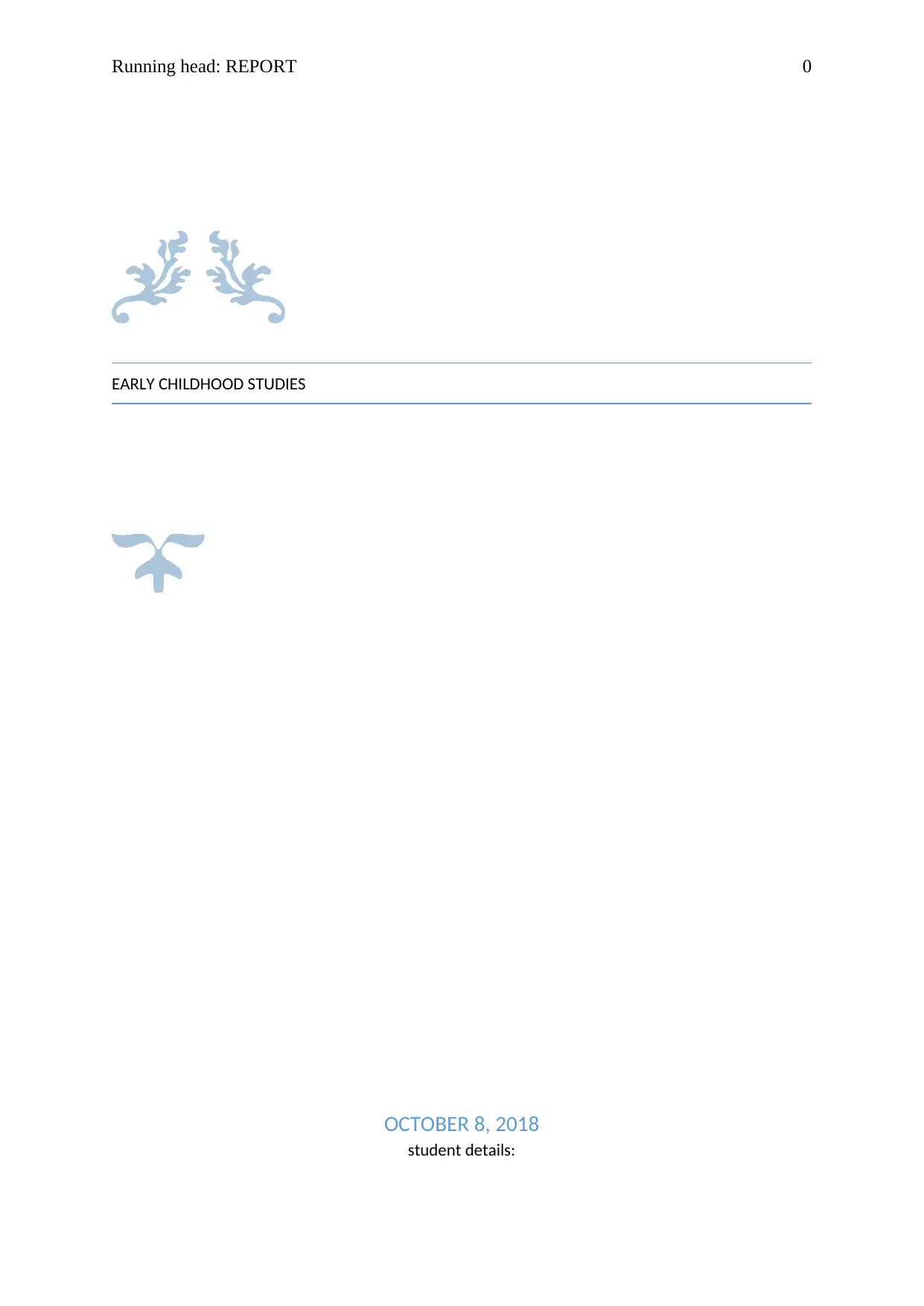
Running head: REPORT 0
EARLY CHILDHOOD STUDIES
OCTOBER 8, 2018
student details:
EARLY CHILDHOOD STUDIES
OCTOBER 8, 2018
student details:
Paraphrase This Document
Need a fresh take? Get an instant paraphrase of this document with our AI Paraphraser
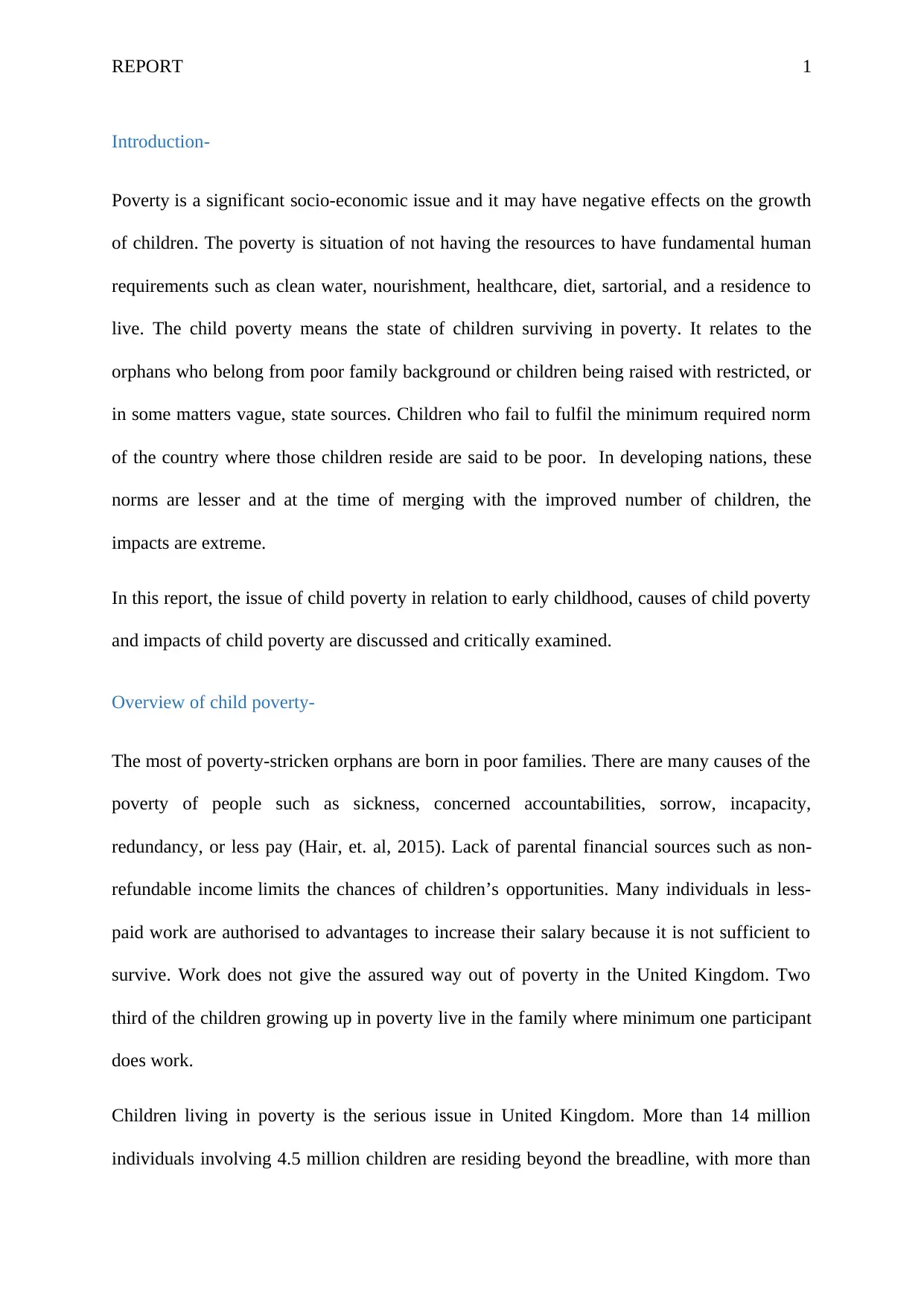
REPORT 1
Introduction-
Poverty is a significant socio-economic issue and it may have negative effects on the growth
of children. The poverty is situation of not having the resources to have fundamental human
requirements such as clean water, nourishment, healthcare, diet, sartorial, and a residence to
live. The child poverty means the state of children surviving in poverty. It relates to the
orphans who belong from poor family background or children being raised with restricted, or
in some matters vague, state sources. Children who fail to fulfil the minimum required norm
of the country where those children reside are said to be poor. In developing nations, these
norms are lesser and at the time of merging with the improved number of children, the
impacts are extreme.
In this report, the issue of child poverty in relation to early childhood, causes of child poverty
and impacts of child poverty are discussed and critically examined.
Overview of child poverty-
The most of poverty-stricken orphans are born in poor families. There are many causes of the
poverty of people such as sickness, concerned accountabilities, sorrow, incapacity,
redundancy, or less pay (Hair, et. al, 2015). Lack of parental financial sources such as non-
refundable income limits the chances of children’s opportunities. Many individuals in less-
paid work are authorised to advantages to increase their salary because it is not sufficient to
survive. Work does not give the assured way out of poverty in the United Kingdom. Two
third of the children growing up in poverty live in the family where minimum one participant
does work.
Children living in poverty is the serious issue in United Kingdom. More than 14 million
individuals involving 4.5 million children are residing beyond the breadline, with more than
Introduction-
Poverty is a significant socio-economic issue and it may have negative effects on the growth
of children. The poverty is situation of not having the resources to have fundamental human
requirements such as clean water, nourishment, healthcare, diet, sartorial, and a residence to
live. The child poverty means the state of children surviving in poverty. It relates to the
orphans who belong from poor family background or children being raised with restricted, or
in some matters vague, state sources. Children who fail to fulfil the minimum required norm
of the country where those children reside are said to be poor. In developing nations, these
norms are lesser and at the time of merging with the improved number of children, the
impacts are extreme.
In this report, the issue of child poverty in relation to early childhood, causes of child poverty
and impacts of child poverty are discussed and critically examined.
Overview of child poverty-
The most of poverty-stricken orphans are born in poor families. There are many causes of the
poverty of people such as sickness, concerned accountabilities, sorrow, incapacity,
redundancy, or less pay (Hair, et. al, 2015). Lack of parental financial sources such as non-
refundable income limits the chances of children’s opportunities. Many individuals in less-
paid work are authorised to advantages to increase their salary because it is not sufficient to
survive. Work does not give the assured way out of poverty in the United Kingdom. Two
third of the children growing up in poverty live in the family where minimum one participant
does work.
Children living in poverty is the serious issue in United Kingdom. More than 14 million
individuals involving 4.5 million children are residing beyond the breadline, with more than
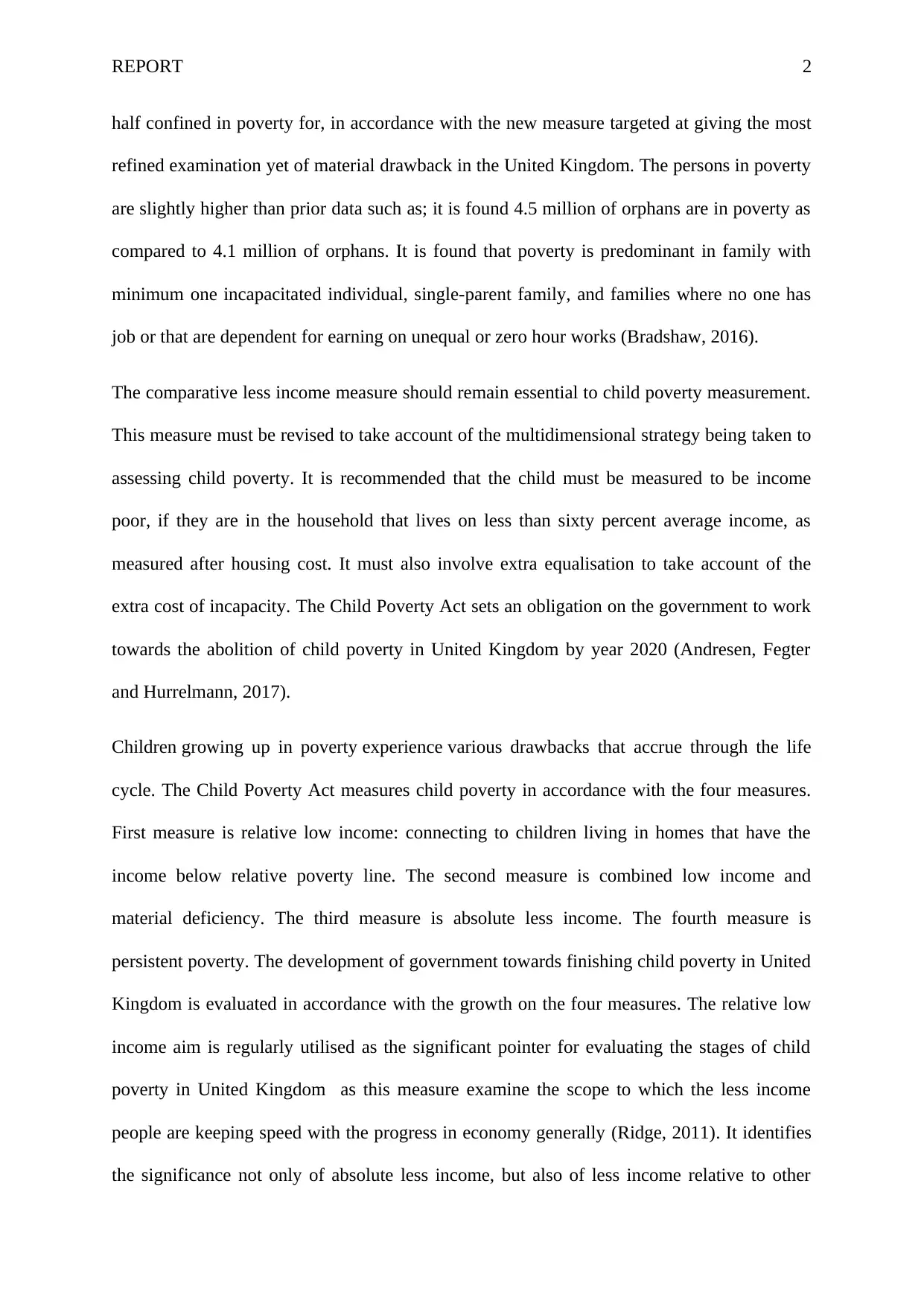
REPORT 2
half confined in poverty for, in accordance with the new measure targeted at giving the most
refined examination yet of material drawback in the United Kingdom. The persons in poverty
are slightly higher than prior data such as; it is found 4.5 million of orphans are in poverty as
compared to 4.1 million of orphans. It is found that poverty is predominant in family with
minimum one incapacitated individual, single-parent family, and families where no one has
job or that are dependent for earning on unequal or zero hour works (Bradshaw, 2016).
The comparative less income measure should remain essential to child poverty measurement.
This measure must be revised to take account of the multidimensional strategy being taken to
assessing child poverty. It is recommended that the child must be measured to be income
poor, if they are in the household that lives on less than sixty percent average income, as
measured after housing cost. It must also involve extra equalisation to take account of the
extra cost of incapacity. The Child Poverty Act sets an obligation on the government to work
towards the abolition of child poverty in United Kingdom by year 2020 (Andresen, Fegter
and Hurrelmann, 2017).
Children growing up in poverty experience various drawbacks that accrue through the life
cycle. The Child Poverty Act measures child poverty in accordance with the four measures.
First measure is relative low income: connecting to children living in homes that have the
income below relative poverty line. The second measure is combined low income and
material deficiency. The third measure is absolute less income. The fourth measure is
persistent poverty. The development of government towards finishing child poverty in United
Kingdom is evaluated in accordance with the growth on the four measures. The relative low
income aim is regularly utilised as the significant pointer for evaluating the stages of child
poverty in United Kingdom as this measure examine the scope to which the less income
people are keeping speed with the progress in economy generally (Ridge, 2011). It identifies
the significance not only of absolute less income, but also of less income relative to other
half confined in poverty for, in accordance with the new measure targeted at giving the most
refined examination yet of material drawback in the United Kingdom. The persons in poverty
are slightly higher than prior data such as; it is found 4.5 million of orphans are in poverty as
compared to 4.1 million of orphans. It is found that poverty is predominant in family with
minimum one incapacitated individual, single-parent family, and families where no one has
job or that are dependent for earning on unequal or zero hour works (Bradshaw, 2016).
The comparative less income measure should remain essential to child poverty measurement.
This measure must be revised to take account of the multidimensional strategy being taken to
assessing child poverty. It is recommended that the child must be measured to be income
poor, if they are in the household that lives on less than sixty percent average income, as
measured after housing cost. It must also involve extra equalisation to take account of the
extra cost of incapacity. The Child Poverty Act sets an obligation on the government to work
towards the abolition of child poverty in United Kingdom by year 2020 (Andresen, Fegter
and Hurrelmann, 2017).
Children growing up in poverty experience various drawbacks that accrue through the life
cycle. The Child Poverty Act measures child poverty in accordance with the four measures.
First measure is relative low income: connecting to children living in homes that have the
income below relative poverty line. The second measure is combined low income and
material deficiency. The third measure is absolute less income. The fourth measure is
persistent poverty. The development of government towards finishing child poverty in United
Kingdom is evaluated in accordance with the growth on the four measures. The relative low
income aim is regularly utilised as the significant pointer for evaluating the stages of child
poverty in United Kingdom as this measure examine the scope to which the less income
people are keeping speed with the progress in economy generally (Ridge, 2011). It identifies
the significance not only of absolute less income, but also of less income relative to other
⊘ This is a preview!⊘
Do you want full access?
Subscribe today to unlock all pages.

Trusted by 1+ million students worldwide
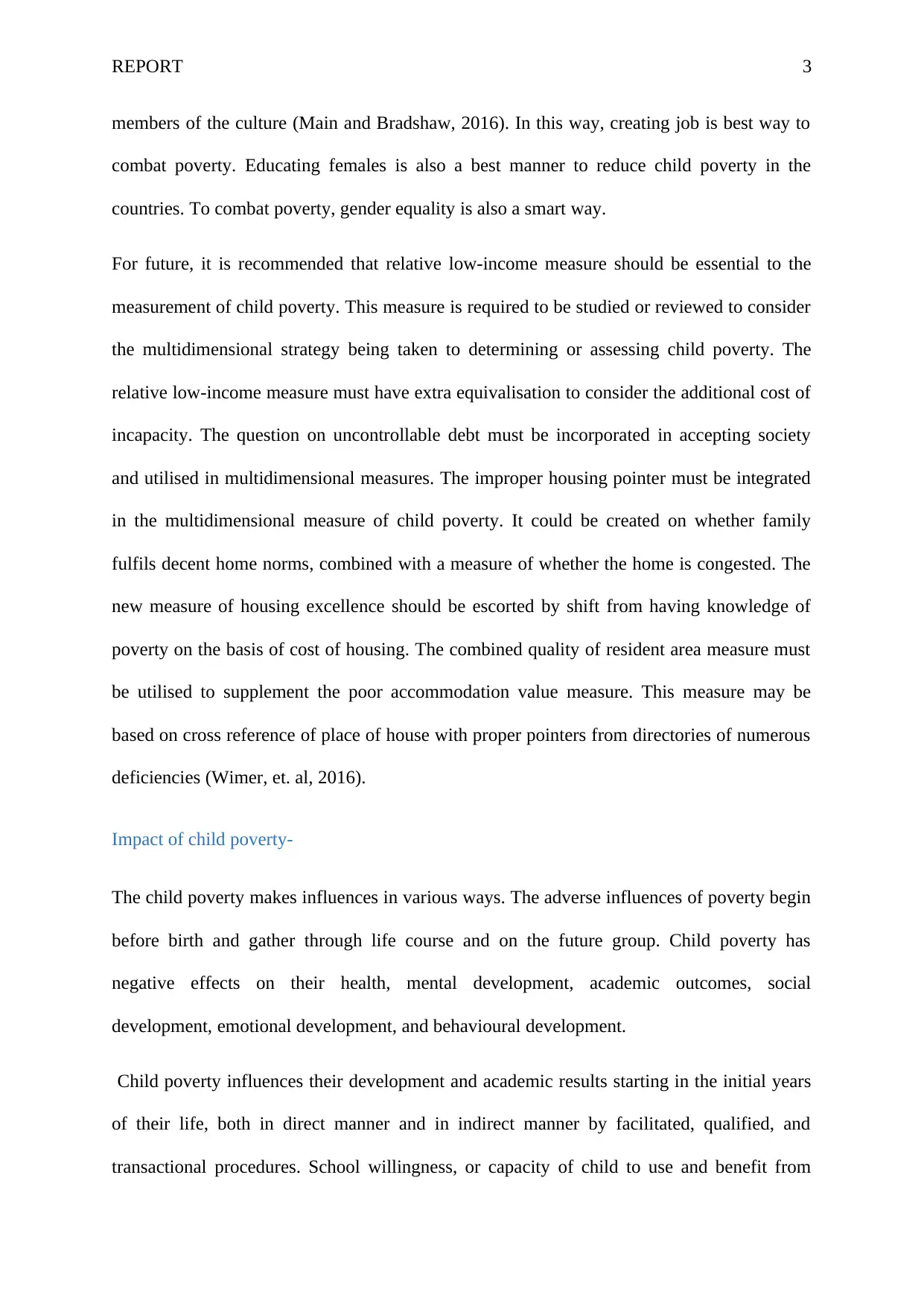
REPORT 3
members of the culture (Main and Bradshaw, 2016). In this way, creating job is best way to
combat poverty. Educating females is also a best manner to reduce child poverty in the
countries. To combat poverty, gender equality is also a smart way.
For future, it is recommended that relative low-income measure should be essential to the
measurement of child poverty. This measure is required to be studied or reviewed to consider
the multidimensional strategy being taken to determining or assessing child poverty. The
relative low-income measure must have extra equivalisation to consider the additional cost of
incapacity. The question on uncontrollable debt must be incorporated in accepting society
and utilised in multidimensional measures. The improper housing pointer must be integrated
in the multidimensional measure of child poverty. It could be created on whether family
fulfils decent home norms, combined with a measure of whether the home is congested. The
new measure of housing excellence should be escorted by shift from having knowledge of
poverty on the basis of cost of housing. The combined quality of resident area measure must
be utilised to supplement the poor accommodation value measure. This measure may be
based on cross reference of place of house with proper pointers from directories of numerous
deficiencies (Wimer, et. al, 2016).
Impact of child poverty-
The child poverty makes influences in various ways. The adverse influences of poverty begin
before birth and gather through life course and on the future group. Child poverty has
negative effects on their health, mental development, academic outcomes, social
development, emotional development, and behavioural development.
Child poverty influences their development and academic results starting in the initial years
of their life, both in direct manner and in indirect manner by facilitated, qualified, and
transactional procedures. School willingness, or capacity of child to use and benefit from
members of the culture (Main and Bradshaw, 2016). In this way, creating job is best way to
combat poverty. Educating females is also a best manner to reduce child poverty in the
countries. To combat poverty, gender equality is also a smart way.
For future, it is recommended that relative low-income measure should be essential to the
measurement of child poverty. This measure is required to be studied or reviewed to consider
the multidimensional strategy being taken to determining or assessing child poverty. The
relative low-income measure must have extra equivalisation to consider the additional cost of
incapacity. The question on uncontrollable debt must be incorporated in accepting society
and utilised in multidimensional measures. The improper housing pointer must be integrated
in the multidimensional measure of child poverty. It could be created on whether family
fulfils decent home norms, combined with a measure of whether the home is congested. The
new measure of housing excellence should be escorted by shift from having knowledge of
poverty on the basis of cost of housing. The combined quality of resident area measure must
be utilised to supplement the poor accommodation value measure. This measure may be
based on cross reference of place of house with proper pointers from directories of numerous
deficiencies (Wimer, et. al, 2016).
Impact of child poverty-
The child poverty makes influences in various ways. The adverse influences of poverty begin
before birth and gather through life course and on the future group. Child poverty has
negative effects on their health, mental development, academic outcomes, social
development, emotional development, and behavioural development.
Child poverty influences their development and academic results starting in the initial years
of their life, both in direct manner and in indirect manner by facilitated, qualified, and
transactional procedures. School willingness, or capacity of child to use and benefit from
Paraphrase This Document
Need a fresh take? Get an instant paraphrase of this document with our AI Paraphraser
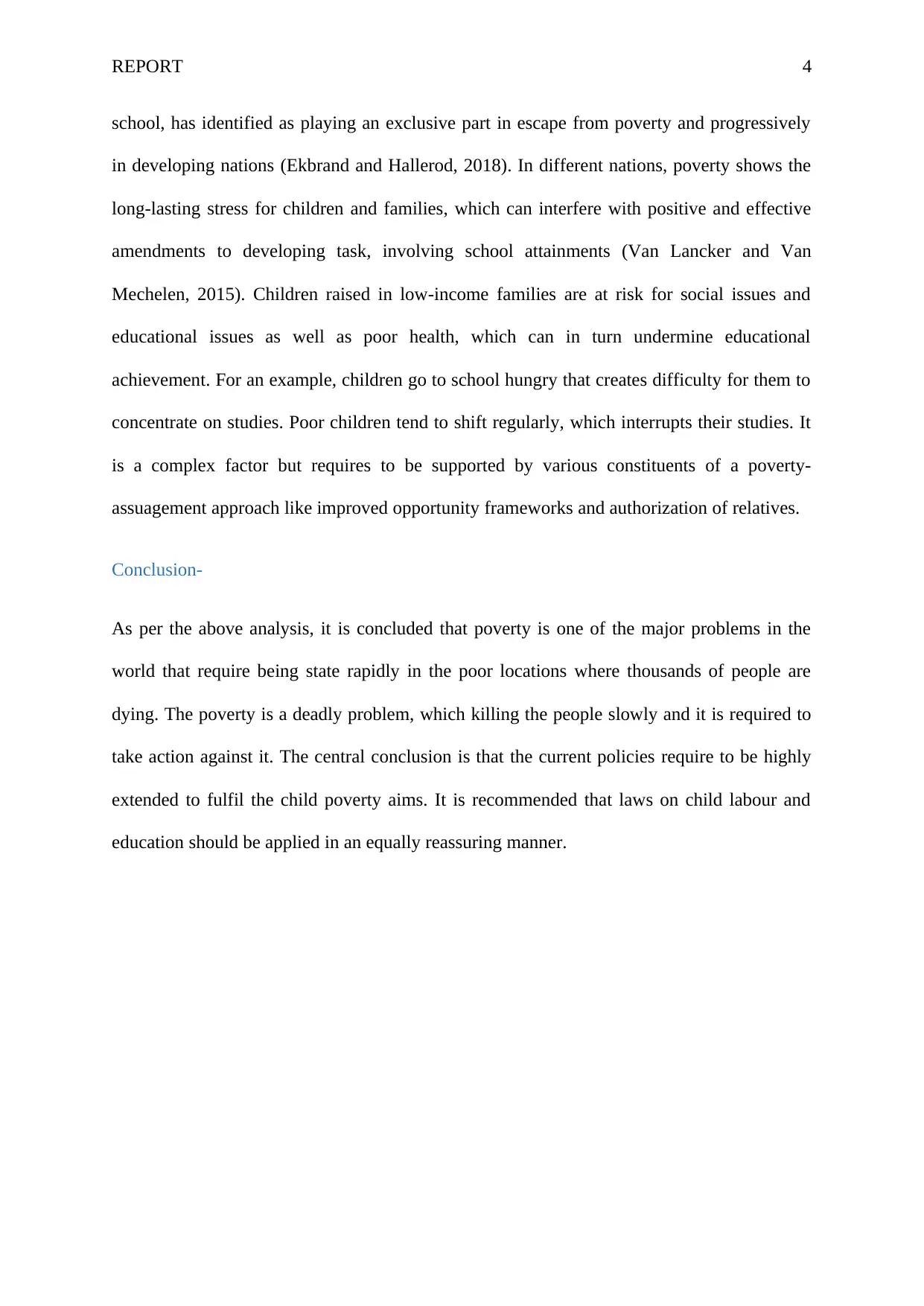
REPORT 4
school, has identified as playing an exclusive part in escape from poverty and progressively
in developing nations (Ekbrand and Hallerod, 2018). In different nations, poverty shows the
long-lasting stress for children and families, which can interfere with positive and effective
amendments to developing task, involving school attainments (Van Lancker and Van
Mechelen, 2015). Children raised in low‐income families are at risk for social issues and
educational issues as well as poor health, which can in turn undermine educational
achievement. For an example, children go to school hungry that creates difficulty for them to
concentrate on studies. Poor children tend to shift regularly, which interrupts their studies. It
is a complex factor but requires to be supported by various constituents of a poverty‐
assuagement approach like improved opportunity frameworks and authorization of relatives.
Conclusion-
As per the above analysis, it is concluded that poverty is one of the major problems in the
world that require being state rapidly in the poor locations where thousands of people are
dying. The poverty is a deadly problem, which killing the people slowly and it is required to
take action against it. The central conclusion is that the current policies require to be highly
extended to fulfil the child poverty aims. It is recommended that laws on child labour and
education should be applied in an equally reassuring manner.
school, has identified as playing an exclusive part in escape from poverty and progressively
in developing nations (Ekbrand and Hallerod, 2018). In different nations, poverty shows the
long-lasting stress for children and families, which can interfere with positive and effective
amendments to developing task, involving school attainments (Van Lancker and Van
Mechelen, 2015). Children raised in low‐income families are at risk for social issues and
educational issues as well as poor health, which can in turn undermine educational
achievement. For an example, children go to school hungry that creates difficulty for them to
concentrate on studies. Poor children tend to shift regularly, which interrupts their studies. It
is a complex factor but requires to be supported by various constituents of a poverty‐
assuagement approach like improved opportunity frameworks and authorization of relatives.
Conclusion-
As per the above analysis, it is concluded that poverty is one of the major problems in the
world that require being state rapidly in the poor locations where thousands of people are
dying. The poverty is a deadly problem, which killing the people slowly and it is required to
take action against it. The central conclusion is that the current policies require to be highly
extended to fulfil the child poverty aims. It is recommended that laws on child labour and
education should be applied in an equally reassuring manner.
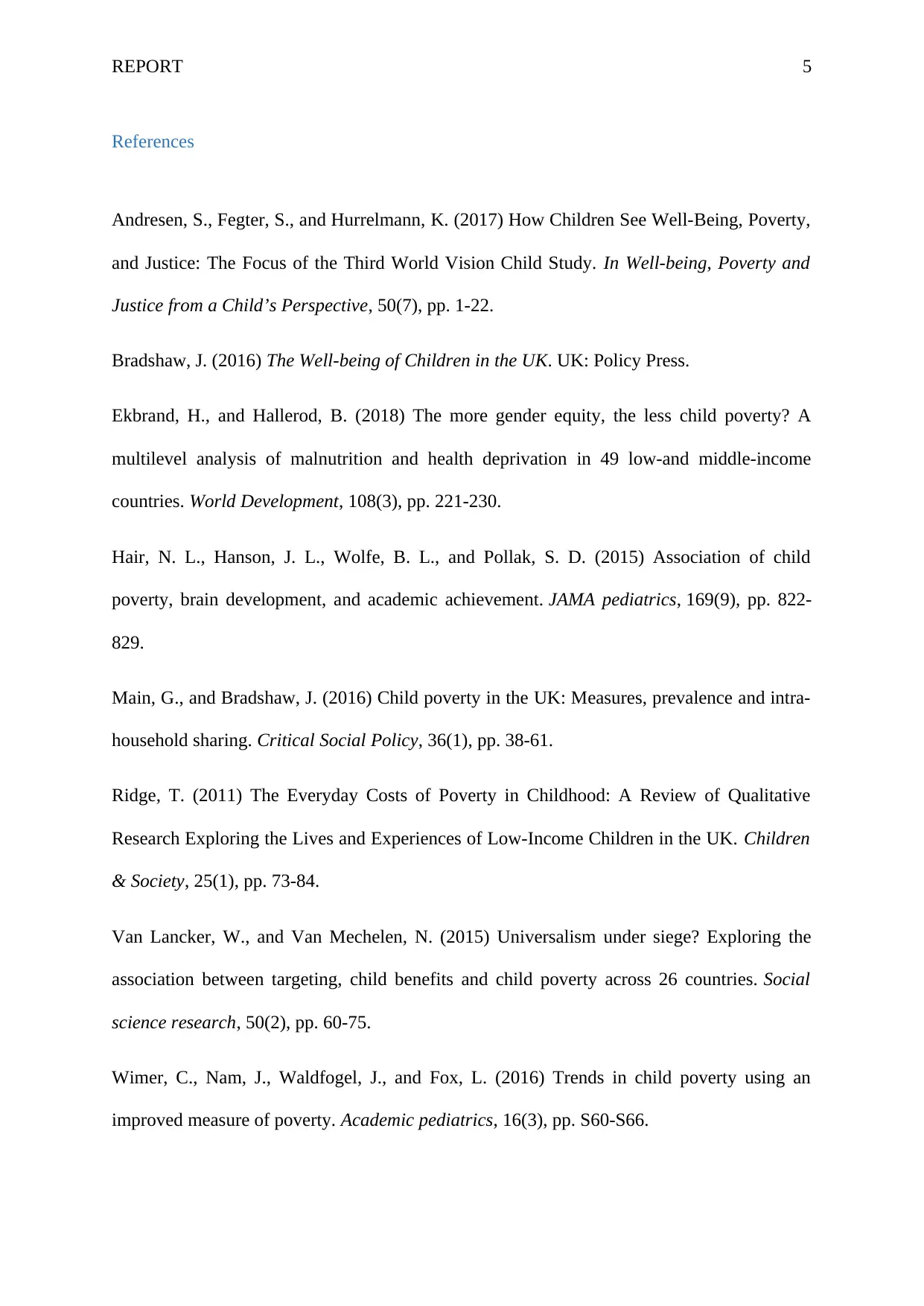
REPORT 5
References
Andresen, S., Fegter, S., and Hurrelmann, K. (2017) How Children See Well-Being, Poverty,
and Justice: The Focus of the Third World Vision Child Study. In Well-being, Poverty and
Justice from a Child’s Perspective, 50(7), pp. 1-22.
Bradshaw, J. (2016) The Well-being of Children in the UK. UK: Policy Press.
Ekbrand, H., and Hallerod, B. (2018) The more gender equity, the less child poverty? A
multilevel analysis of malnutrition and health deprivation in 49 low-and middle-income
countries. World Development, 108(3), pp. 221-230.
Hair, N. L., Hanson, J. L., Wolfe, B. L., and Pollak, S. D. (2015) Association of child
poverty, brain development, and academic achievement. JAMA pediatrics, 169(9), pp. 822-
829.
Main, G., and Bradshaw, J. (2016) Child poverty in the UK: Measures, prevalence and intra-
household sharing. Critical Social Policy, 36(1), pp. 38-61.
Ridge, T. (2011) The Everyday Costs of Poverty in Childhood: A Review of Qualitative
Research Exploring the Lives and Experiences of Low-Income Children in the UK. Children
& Society, 25(1), pp. 73-84.
Van Lancker, W., and Van Mechelen, N. (2015) Universalism under siege? Exploring the
association between targeting, child benefits and child poverty across 26 countries. Social
science research, 50(2), pp. 60-75.
Wimer, C., Nam, J., Waldfogel, J., and Fox, L. (2016) Trends in child poverty using an
improved measure of poverty. Academic pediatrics, 16(3), pp. S60-S66.
References
Andresen, S., Fegter, S., and Hurrelmann, K. (2017) How Children See Well-Being, Poverty,
and Justice: The Focus of the Third World Vision Child Study. In Well-being, Poverty and
Justice from a Child’s Perspective, 50(7), pp. 1-22.
Bradshaw, J. (2016) The Well-being of Children in the UK. UK: Policy Press.
Ekbrand, H., and Hallerod, B. (2018) The more gender equity, the less child poverty? A
multilevel analysis of malnutrition and health deprivation in 49 low-and middle-income
countries. World Development, 108(3), pp. 221-230.
Hair, N. L., Hanson, J. L., Wolfe, B. L., and Pollak, S. D. (2015) Association of child
poverty, brain development, and academic achievement. JAMA pediatrics, 169(9), pp. 822-
829.
Main, G., and Bradshaw, J. (2016) Child poverty in the UK: Measures, prevalence and intra-
household sharing. Critical Social Policy, 36(1), pp. 38-61.
Ridge, T. (2011) The Everyday Costs of Poverty in Childhood: A Review of Qualitative
Research Exploring the Lives and Experiences of Low-Income Children in the UK. Children
& Society, 25(1), pp. 73-84.
Van Lancker, W., and Van Mechelen, N. (2015) Universalism under siege? Exploring the
association between targeting, child benefits and child poverty across 26 countries. Social
science research, 50(2), pp. 60-75.
Wimer, C., Nam, J., Waldfogel, J., and Fox, L. (2016) Trends in child poverty using an
improved measure of poverty. Academic pediatrics, 16(3), pp. S60-S66.
⊘ This is a preview!⊘
Do you want full access?
Subscribe today to unlock all pages.

Trusted by 1+ million students worldwide
1 out of 6
Related Documents
Your All-in-One AI-Powered Toolkit for Academic Success.
+13062052269
info@desklib.com
Available 24*7 on WhatsApp / Email
![[object Object]](/_next/static/media/star-bottom.7253800d.svg)
Unlock your academic potential
Copyright © 2020–2025 A2Z Services. All Rights Reserved. Developed and managed by ZUCOL.





